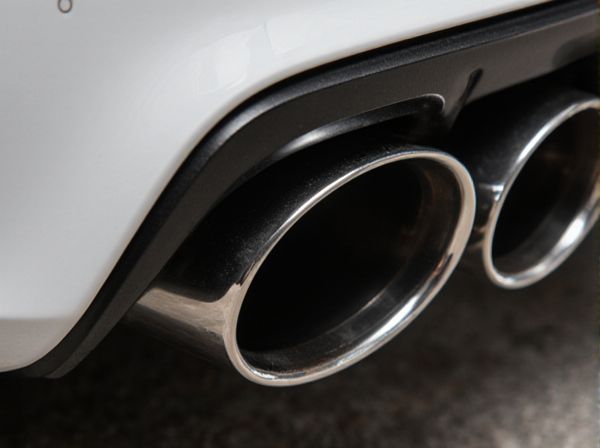
Photo illustration: Straight Pipe vs Muffled Pipe
A straight pipe exhaust enhances engine performance by reducing backpressure and allowing exhaust gases to flow freely, resulting in increased horsepower and a louder, more aggressive sound. A muffled pipe, on the other hand, prioritizes noise reduction and a quieter ride by using sound-dampening materials, which can slightly decrease performance due to increased backpressure. Choosing between a straight pipe and muffled pipe depends on whether You value maximum power and sound or a more subdued, comfortable driving experience.
Table of Comparison
| Feature | Straight Pipe | Muffled Pipe |
|---|---|---|
| Noise Level | High, loud exhaust note | Low, quiet operation |
| Backpressure | Minimal, improved flow | Higher, restricts flow |
| Performance Impact | Potential increase in horsepower | Maintains standard power output |
| Emissions | Usually higher, less filtration | Lower, includes catalytic converter |
| Legal Compliance | Often non-compliant with noise regulations | Typically meets emissions and noise laws |
| Cost | Lower installation cost | Higher due to components and design |
| Durability | Varies, usually simpler build | More complex, often longer-lasting |
Introduction to Straight Pipe vs Muffled Pipe
Straight pipes offer minimal airflow resistance, enhancing engine performance by maximizing exhaust gas flow and increasing horsepower. Muffled pipes incorporate sound-dampening chambers or baffles to reduce noise levels while slightly restricting exhaust flow to meet legal and comfort requirements. Selecting between straight and muffled pipes depends on balancing desired sound intensity, emissions compliance, and engine efficiency.
What Is a Straight Pipe Exhaust System?
A straight pipe exhaust system is a type of exhaust setup that eliminates mufflers and catalytic converters, allowing exhaust gases to flow freely through a single, straight pipe. This design reduces backpressure, potentially increasing engine performance and producing a louder, more aggressive exhaust sound. Commonly used in performance and racing vehicles, straight pipe systems prioritize maximizing exhaust flow over noise reduction and emissions control.
What Is a Muffled Pipe Exhaust System?
A muffled pipe exhaust system incorporates a silencer within the pipe to reduce noise levels generated by engine combustion, enhancing sound control compared to a straight pipe, which lacks any noise-dampening components. This system typically uses chambers, baffles, or perforated tubes lined with sound-absorbing material, effectively minimizing exhaust noise while maintaining efficient gas flow. Optimizing vehicle performance and complying with noise regulations, muffled pipe exhaust systems provide a quieter, more environmentally friendly solution than straight pipes.
Sound Differences: Straight Pipe vs Muffled Pipe
Straight pipes produce a louder, more aggressive exhaust note by allowing gases to flow freely without restrictions, resulting in a raw and high-pitched sound. Muffled pipes incorporate sound-absorbing materials or chambers that reduce noise levels and create a deeper, quieter, and more refined exhaust tone. The choice between straight and muffled pipes significantly impacts vehicle sound profile, with straight pipes favored for performance enthusiasts seeking maximum volume and muffled pipes preferred for noise control and comfort.
Performance Impact of Each Exhaust Type
Straight pipes enhance exhaust flow by reducing backpressure, resulting in increased horsepower and torque, especially at higher RPMs. Muffled pipes prioritize noise reduction through sound-dampening materials, which can slightly restrict exhaust flow and reduce peak engine performance. Choosing between straight and muffled pipes depends on balancing desired power gains against noise levels and vehicle regulations.
Legal and Environmental Considerations
Straight pipes are often illegal in many regions because they bypass emissions control systems, causing increased pollution and violating environmental regulations such as the Clean Air Act in the United States. Muffled pipes include components like catalytic converters and resonators designed to reduce noise and harmful emissions, ensuring compliance with legal standards and minimizing environmental impact. Vehicle owners must verify local laws regarding exhaust modifications to avoid fines and contribute to air quality preservation.
Installation and Maintenance Comparison
Straight pipe systems offer easier installation due to fewer components and simpler alignment, reducing labor time and costs compared to muffled pipes that require additional parts like mufflers and resonators. Maintenance of straight pipes is generally minimal because of their straightforward design, while muffled pipes often demand more frequent inspections and repairs to maintain noise reduction efficiency. Choosing straight pipes can lower long-term upkeep expenses, but muffled pipes provide better noise control critical for urban and residential installations.
Cost Analysis: Straight Pipe vs Muffled Pipe
Straight pipes typically cost less upfront due to their simpler design and fewer materials compared to muffled pipes, which require additional components like chambers or baffles for noise reduction. While straight pipes offer a budget-friendly option, muffled pipes involve higher installation and maintenance expenses associated with their complex structure and sound-dampening features. Evaluating long-term costs, muffled pipes can incur increased operational expenses but may reduce noise pollution compliance fines, whereas straight pipes might lead to higher costs related to noise-related penalties and environmental restrictions.
Pros and Cons of Straight Pipe Exhaust
Straight pipe exhaust systems offer increased exhaust flow and reduced back pressure, resulting in improved engine performance and horsepower gains. However, they produce significantly louder noise levels, which can lead to noise pollution and may violate local noise regulations. The lack of muffling also reduces emissions control, potentially causing increased environmental impact and failing emissions tests.
Pros and Cons of Muffled Pipe Exhaust
Muffled pipe exhaust systems reduce noise pollution significantly, making them ideal for urban environments and ensuring compliance with noise regulations. They often improve exhaust gas scavenging, enhancing engine efficiency and performance while providing a quieter and more comfortable driving experience. However, muffled pipes may slightly restrict exhaust flow compared to straight pipes, potentially limiting maximum horsepower and horsepower gains.
 caratoz.com
caratoz.com